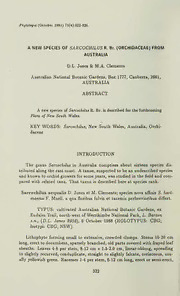
A NEW SPECIES OF SARCOCHILUS R. BR. ORCHIDACEAE FROM AUSTRALIA PDF
Preview A NEW SPECIES OF SARCOCHILUS R. BR. ORCHIDACEAE FROM AUSTRALIA
Phytologia(October 1991) 71(4):322-325. A NEW SPECIES OF SARCOCHILUS R. Br. (ORCHIDACEAE) FROM AUSTRALIA D.L. Jones h M.A. Clements Australian National Botanic Gardens, Box 1777, Canberra, 2601, AUSTRALIA ABSTRACT A new species ofSarcochilusR. Br. is described for theforthcoming Flora ofNew South. Wales. KEY WORDS: Sarcochilus, New South Wales, Australia, Orchi- daceae INTRODUCTION The genus Sarcochilus in Australia comprises about sixteen species dis- tributed along theeast coast. A taxon, suspected to be an undescribed species and known to orchid growers for some years, was studied in the field and com- pared with related taxa. That taxon is described here at species rank. Sarcochilus aequalis D. Jones et M. Clements; species nova affinis S. hart- mannii F. Muell. a qua floribus fulvis et racemis perbrevioribus differt. TYPUS: cultivated Australian NationaJ Botanic Gardens, ex Eudales Trail, north-west ofWerrikimbe National Park, L. Barton s.n., {D.L. Jones 2952), 6 October 1988 (HOLOTYPUS: CBG; Isotypi: CBG, NSW). Lithophyte forming small to extensive, crowded clumps. Stems 10-20 cm long, erect to decumbent,sparsely branched, old parts covered with frayed leaf sheaths. Leaves 4-8 per stem, 8-12 cm x 1.5-2.0 cm, linear-oblong, spreading to slightly recurved, conduplicate, straight to slightly falcate, coriaceous, usu- ally yellowish green. Racemes 1-4 per stem, 6-12 cm long, erect or semi-erect, 322 Jones Si Clements: New Sarcochilus fioni Australia 323 Figure 1. Sarcochilus aequalis. a, flowering plant; b, flower from front; c, flower from side; d, labellum from above; e, labellum from side; f, longitudinal section of labellum; g, column from side. Scale bar for all = 5 mm. PHYTOLOGIA 324 volume 71(4):322-325 October 1991 bearing 5-10, crowded flowers; peduncleabout equalin length to rachis. Flow- ers 2.0-2.5 cm across, cream with a few reddish spots towards the base of the perianth segments and red bars on the labellum; perianth segments cupped to spreading. Floral bracts ca. 2 mm x 2 mm, ovate, acuminate. Pedicels 8-12 mm long, mottled and spotted with dark purple. Ovary 3-5 mm long, linear- ovoid. Dorsal sepal 9-12 mm x 5-7 mm, broadly elliptical, obtuse, imbricate, narrowed to base. Lateral sepals 9-12 mm x 4.5-7.0 mm, elliptical to broadly elliptical, divergent, obtuse to subacute, narrowed to base. Petals 7.5-12.0 mm X 2.5-4.0 mm, oblong-spathulate, obtuse. Labellum 7-8 mm across when flattened, hinged at the base on a short claw; midlobe ca. 0.8 mm x 1 mm, mm yellowish; spur ca. 1.5-2.0 long, subcorneal, fleshy,obliquely decurved; cal- lus consisting ofa fleshy ridge extending along the center line of the midlobe, anvil shaped in longitudinal section; lateral lobes ca. 2.5-3.0 mmx 2.5-3.0 mm, mm orbicular, prominently striped with red. Column ca. 1.5 long, projected mm forwards from the ovary. Column foot ca. 1.5-2.0 long, at right angles to column, incurved near apex. Anther ca. 1.5 mm x 1.5 mm, with a very short, mm mm upcurved rostrum. Stigma ca. 0.6 across, sunken. Pollinarium ca. 1.7 X 1.2 mm; poDinia ca. 0.7 mm x 0.5 mm, orbicular, orange, waxy; stipe ca. 0.6 mm mm long; viscidium ca. 0.3 long. Capsule not seen. Specimens Examined: No herbarium specimens occur apart from the type collection. Distribution and Habitat: Reported by orchid growers to occur in suitable sites on the Northern Tablelands of New South Wales between the Clarence River and the Manning River. This species occurs in gorges and along steep slopes, growing on rock outcrops, usually in semishade or filtered sun. Plants have also been found growing on rocks adjacent to waterfalls. Flowering period: .August and September. Affinities: Sarcochilus aequahsis closely related to S. hartmanmiF. Muell., the typeofwhich was collected from Spring BluffnearToowoombain southern Queensland (Clements 1989). Both species have been cultivated for many years and 5. aequalis has been known by orchid growers as the southern form of S. hartmannii. It is easily distinguished from that species by its cream flowers which are borne on relatively short, stiffly erect racemes in which the peduncle and rachis are of similar length. In 5. hartmannii the white flowers are borne on long, arching racemes, the peduncle ofwhich is much longer than the rachis. When grown together in collections, growers report that S. aequalis consistently flowers two or three weeks earlier than 5. hartmannii. The two species are not sympatric and in fact are separated by a distance ofabout 400 km. Notes: Sarcochilus aequalis has been used in breeding programs to produce hybrid progeny. Conservation Status: Sarcochilus aequalis is present in National Parks but is still threatened by collectors; suggested status is 3RC according to the cri- Jones &: Clements: New Sarcochilus horn Australia 325 teria of Briggs k Leigh (1988). Etymology: From the Latin ^aequalis\ of uniform or similar size; in refer- ence to the similar size of the peduncle and rachis of the inflorescence. ACKNOWLEDGMENTS We wish to thank Lex Barton for discussions about this species and assis- tance in the field, John Roberts forinformation and specimens from cultivated plants, and Barbara Jones for processing the manuscript. REFERENCES ; Briggs, J.D. k J.H. Leigh. 1988. Rare or Threatened Australian Plants. Australian National Parks and Wildlife Service. Special Publication No. 14. Clements, M.A. 1989. Catalogue of Australian Orchidaceae. Aust. Orch. Res. 1:1-160.
